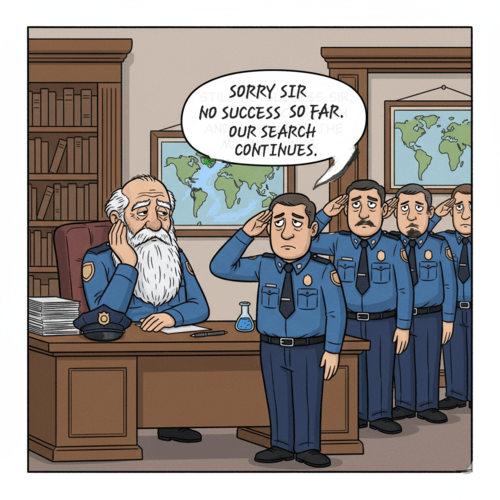Transitional Fossils: Why the Missing Links Are Still Missing
Evolution is taught in schools and universities as settled science, yet one of its most fundamental predictions remains conspicuously unfulfilled. Charles Darwin himself acknowledged the fossil record’s lack of intermediate forms posed “the most obvious and gravest objection” to his theory. Today, more than 165 years after the publication of On the Origin of Species, evolutionists are still searching for convincing transitional fossils—creatures that would show one kind of organism gradually transforming into another.
Despite claims of “overwhelming evidence,” the missing links remain missing. Why?
HISTORICAL ADMISSIONS: EVEN EVOLUTIONISTS SEE THE PROBLEM
The shortage of transitional fossils isn’t just a creationist talking point—it’s been acknowledged by prominent evolutionists themselves. In 1979, Dr. Colin Patterson, senior palaeontologist at the British Museum of Natural History, wrote candidly to creationist Luther Sunderland: “I fully agree with your comments on the lack of direct illustration of evolutionary transitions in my book. If I knew of any, fossil or living, I would certainly have included them.”
When pressed for examples he could confidently present as transitional forms, Patterson admitted he could provide “not one.”
This honesty stands in stark contrast to the confident assertions we often hear today. But Patterson wasn’t alone in recognising the problem. The early history of “missing link” discoveries is littered with embarrassing retractions. Remember these:
- Piltdown Man (1912-1953): Hailed for decades as the crucial link between apes and humans, this “fossil” was eventually exposed as a deliberate fraud—a human skull combined with an orangutan’s jaw, artificially aged and planted.
- Nebraska Man (1922-1927): An entire “ape-man” reconstruction was built around a single tooth, complete with artistic depictions of this supposed human ancestor and his family. The tooth later proved to belong to an extinct pig.
- Java Man (1890s): Discoverer Eugene Dubois later admitted that the skull cap and femur bone—found 50 feet apart—may not have belonged to the same creature, and the femur was likely from a modern human.
The pattern is telling: premature announcements followed by quiet retractions once the evidence is examined more carefully.
CURRENT STATE OF AFFAIRS: REDEFINING THE PROBLEM
Fast-forward to 2025, and evolutionists now claim “mountains of evidence” for their theory. But a closer look reveals a subtle shift in strategy. Rather than finding true intermediate forms, the approach has changed to redefining existing fossils as “transitional.”
This involves cherry-picking mosaic features—characteristics from multiple distinct kinds of organisms—and presenting them as evidence of evolution in progress. Recent discoveries, like the Ethiopian Homo fossils found in August 2025, continue this trend by adding new branches to the supposed human family tree while creating more gaps, not bridges between different kinds.
Even evolutionists have acknowledged significant challenges with the fossil record:
- Charles Darwin in On the Origin of Species (Chapter 9: “On the Imperfection of the Geological Record”) admitted the lack of transitional forms was “probably the gravest and most obvious of all the many objections which may be urged against my views.” He attributed this to “the extreme imperfection of the geological record.”
- Stephen Jay Gould and Niles Eldredge developed “punctuated equilibrium” theory, acknowledging the fossil record shows stasis rather than gradual transitions. They proposed instead that evolution occurred in rapid bursts too quick to fossilize.
- David Raup, former curator at the Field Museum of Natural History, noted in Conflicts Between Darwin and Palaeontology (1979) the persistent gaps between major groups in the fossil record.
- Ernst Mayr in What Evolution Is (2001) acknowledged the rarity of transitional forms and the challenges this poses for evolutionary theory.
EXAMINING THE “BEST” EXAMPLES
Let’s examine the four most commonly cited examples of transitional fossils to see if they truly bridge the gaps between major groups:
Fish to Tetrapods: Tiktaalik (2004): Evolutionists claimed this “fishapod” represents the perfect intermediate between fish and four-legged land animals, showing how creatures made the transition from water to land.
The problems:
- Still completely aquatic with functional gills, fins, and scales—no true limbs
- Lacks the flexible neck considered necessary for terrestrial life
- Found in marine sediments, not the shallow-water transitional environment predicted
- Earlier tetrapod (four-legged) tracks have been discovered, undermining the proposed timeline
- The current consensus is this fossil represents a well-designed aquatic creature, not a struggling intermediate
Land Mammals to Whales: Ambulocetus (1994): Evolutionists claimed this “walking whale” demonstrates how land mammals returned to the sea, showing clear transitional features.
The problems:
- More otter-like than whale-like, fully adapted for aquatic life from the start
- Massive gaps remain in the proposed evolutionary sequence (50+ million year jumps)
- The creatures appear and disappear abruptly in the fossil record with no gradual transitions
- Geographic and temporal distribution problems make the proposed sequence unlikely
- Each creature appears fully formed and well-designed for its environment
Dinosaurs to Birds: Archaeopteryx (1861): Evolutionists claimed this feathered fossil proves birds evolved from dinosaurs, and combined reptilian and avian features.
The problems:
- Possessed flight-ready bone structure indicating it was a fully functional bird, and no intermediate
- Claws and teeth are found in some modern birds too (hoatzin chicks have claws; some ducks have teeth)
- Complex feather structure requires a fully integrated flight system—half a wing provides no evolutionary advantage
- Recent discoveries of earlier “bird-like” fossils have disrupted the proposed evolutionary timeline
- Shows design for flight, not evolution toward flight
Apes to Human: Australopithecus afarensis “Lucy” (1974): Evolutionists claimed this bipedal creature represents a crucial link showing how apes evolved into human beings.
The problems:
- Recent CT scans reveal tree-climbing adaptations inconsistent with ground-dwelling bipedalism
- Brain size and body proportions remain essentially chimpanzee-like
- Pelvic reconstruction has been disputed; the creature may have been primarily quadrupedal
- The gap between australopithecines and true humans remains as wide as ever
- Appears designed for its specific ecological niche, not as a transitional form
WHY MISSING LINKS REMAIN MISSING
From a creationist perspective, the persistent absence of transitional fossils makes perfect sense. Here’s why:
Our Theological Foundation
- Genesis describes organisms reproducing “after their kind”—variation within limits, not unlimited transformation
- Created kinds were designed to fill specific ecological roles
- Genetic boundaries prevent major morphological changes between kinds
Our Scientific Observations
- Irreducible complexity: Complex biological systems require all components working together simultaneously—intermediate stages would be non-functional
- Genetic limits: Mutations are typically harmful or neutral; they don’t provide the raw material for major evolutionary leaps
- Stasis in the fossil record: Most species appear suddenly, remain essentially unchanged, then disappear—exactly what we’d expect from special creation
- Missing gradualism: If evolution were true, transitional forms should dominate the fossil record, not be the rare exceptions
Our Alternative Model
The rapid burial of organisms during a global catastrophic flood explains:
- Excellent preservation conditions creating detailed fossils
- Apparent “evolutionary” sequences actually representing ecological zonation (different environments buried in sequence)
- Sudden appearance of complex, fully-formed organisms
- Absence of transitional forms—because they never existed
CONCLUSION: THE EVIDENCE POINTS TO DESIGN
After 165 years of intensive search, the missing links remain missing not because we haven’t looked hard enough, but because they were never there to begin with. The fossil record, rather than supporting gradual evolutionary change, consistently shows the sudden appearance of complex, fully-formed organisms perfectly suited to their environments.
Each supposed “transitional” fossil, when examined carefully, reveals itself to be a well-designed creature perfectly adapted for its specific ecological niche. The evidence points not to undirected evolutionary processes, but to intelligent design and special creation.
The emperor of evolution may claim to wear clothes of “overwhelming evidence,” but the missing transitional fossils reveal a theory still lacking its most fundamental supporting evidence. In science, as in life, what we don’t find can be just as telling as what we do find.
TRANSITIONAL FOSSILS: CAUTIONARY TALES FROM HISTORY—RELATED FAQs
What were Beringer’s Lying Stones (1725)? Johann Bartholomew Adam Beringer, a professor at the University of Würzburg, was the victim of an elaborate prank by jealous colleagues who planted carved limestone “fossils” depicting everything from Hebrew letters to celestial bodies. Beringer published these fake fossils in his book Lithographiae Wirceburgensis, claiming they were divine messages written in stone. When he discovered the hoax, he spent his fortune trying to buy back all copies of his book, but the damage to his reputation was irreversible.
- What was the Cardiff Giant hoax (1869)? The Cardiff Giant was a 10-foot-tall “petrified man” buried on a farm in Cardiff, New York, by tobacconist George Hull as revenge against a Methodist minister who believed in biblical giants. Hull commissioned a sculptor to carve the figure from gypsum, artificially aged it, and had it secretly buried. When “discovered” by well-diggers, it drew thousands of paying visitors before being exposed as a hoax. PT Barnum even created a copy of the fake, calling his version “the real Cardiff Giant.”
- What was suspicious about the Calaveras Skull (1866)? This allegedly ancient human skull was “discovered” in a California gold mine and promoted as evidence of humans living alongside extinct Pleistocene animals. The skull was presented to the California Academy of Sciences and gained national attention, but several features suggested it was a modern skull artificially aged and planted. The hoax was likely perpetrated by miners seeking to fool visiting scientists, highlighting how easily even professional researchers could be deceived by planted evidence.
What were Albert Koch’s Monster Skeletons? Albert Koch, a German fossil collector, created sensational but scientifically fraudulent displays by combining bones from multiple animals into fantastical creatures. His “Missourium” (1840) was assembled from several mastodon skeletons into a 32-foot-long monster, while his “Hydrarchos” (1845) combined multiple whale vertebrae into a 114-foot sea serpent. Koch toured these fabrications across America and Europe, charging admission and claiming they represented unknown prehistoric giants. Both creations amplified public misconceptions about extinct animals while generating substantial profits for their creator.
- How did Archaeoraptor fool National Geographic (1999)? Archaeoraptor was a composite fossil created by Chinese farmers who glued together parts of a bird and a dromaeosaurid dinosaur, then sold it to dealers who marketed it as the “missing link” between dinosaurs and birds. National Geographic published the find in 1999 without proper peer review, calling it proof of bird evolution. CT scans later revealed the fakery, forcing the magazine to publish an embarrassing retraction. The hoax demonstrated how commercial pressures and evolutionary expectations could override scientific caution.
- What was the Fly in Amber hoax (1993)? Scientists claimed to have extracted DNA from a 30-million-year-old fly preserved in amber, seemingly validating the premise of the movie Jurassic Park. The research was published in a peer-reviewed journal and received worldwide media attention as evidence that ancient DNA could survive for millions of years. However, subsequent investigations revealed that the “ancient” DNA was actually from modern bacterial contamination. The incident showed how exciting discoveries that fit popular narratives can bypass normal scientific scepticism, even in prestigious journals.
What patterns do these hoaxes reveal about fossil evidence? These frauds span three centuries and various motives—from academic revenge (Beringer’s Lying Stones) to financial gain (Cardiff Giant, Koch’s monsters) to career advancement (Archaeoraptor, Fly in Amber hoax). They consistently exploited gaps in scientific knowledge and public fascination with prehistoric life. Rather than filling genuine gaps in the fossil record, these hoaxes often created false evidence that temporarily masked the absence of real transitional forms. The pattern reveals how easily preconceptions about evolution and deep time can make both scientists and the public vulnerable to deception.
TRANSITIONAL FOSSILS: OUR RELATED POSTS
- Buried Testimony: Do Fossils Support Creation Or Evolution?
- Did Life’s Four Building Blocks Assemble by Chance?
- Soft Tissue in Fossils: How It Defies Evolutionary Timelines
- Intelligent Design: Is It A God of the Gaps Argument?
- The Fossil Record: Does It Really Show We Evolved from Apes?
- Creation or Evolution: Let the Evidence Speak for Itself
Editor's Pick

Why Christians Fast: The Biblical Discipline’s Very Real Rewards
Why would Christians, who rejoice in the good gifts of food and fellowship, deliberately choose to go without? Isn’t fasting [...]

The Christian Sabbath: Why Did Sunday Replace Saturday?
Consider this: God-fearing Jews who’d faithfully observed Saturday Sabbath for over a thousand years suddenly began gathering for worship on [...]

Did the Early Christians Worship Jesus? The Biblical Evidence
It was a startling transformation: Jewish fishermen who'd spent three years following this itinerant carpenter from Nazareth now begin to [...]

If Jesus is Messiah, Why Aren’t ALL Messianic Prophecies Fulfilled?
If Jesus is truly the Messiah, why hasn't world peace arrived? Why do Jews still face persecution? Why isn't the [...]

When Courage Fails: Will I Be Forgiven If I Deny Christ in Persecution?
The rooster crowed, and Peter remembered. In that devastating moment, the apostle realised he’d just done the unthinkable—three times he’d [...]

What Makes a Godly Dad? 5 Biblical Principles Fathers Need
Modern culture sends fathers mixed messages. Be strong but sensitive. Be involved but not overbearing. Lead but don’t dominate. With [...]

What Makes a Godly Mom? A Scripture-Backed Guide
In our culture’s confusion about gender roles and parenting, the timeless question remains: what makes a godly mother? While secular [...]

Paul’s Mandate for Men: Headship Or Servant Leadership? Or Both?
Modern Christianity has fallen into a trap. We've created an either/or battle between "headship" and "servant leadership," as if these [...]

Should We Stop Using Male Pronouns for God? Why Do We Say No?
A friend of ours arrived eagerly at his first theology class in seminary. But he quickly discovered something troubling: the [...]

Did Old Testament Law Force Women to Marry their Rapists?
**Editor’s Note: This post is part of our series, ‘Satan’s Lies: Common Deceptions in the Church Today’… Viral misinformation abounds [...]
SUPPORT US:
Feel the Holy Spirit's gentle nudge to partner with us?
Donate Online:
Account Name: TRUTHS TO DIE FOR FOUNDATION
Account Number: 10243565459
Bank IFSC: IDFB0043391
Bank Name: IDFC FIRST BANK






